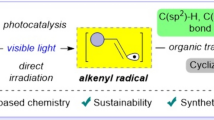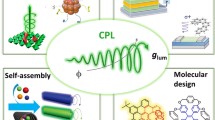Abstract
Novel light-emitting organic materials comprising conjugated oligomers chemically attached via a flexible spacer to an electron–or hole-conducting core were synthesized by Stille cross-coupling methodology and designed for tunable charge injection and optical properties. The hyperbranched structures have been characterized by 1H NMR, 13C NMR, and UV-VIS spectroscopy. The obtained structures show good stability in common organic solvents such as CHCl3, toluene, and CH2Cl2 and exhibit excellent thermal stability. A preliminary electroluminescence properties were also investigated. This class of materials will help to balance charge injection and transport and to spread out the charge recombination zone, thereby significantly improving the device efficiency and lifetime of unpolarized and polarized OLEDs.








Similar content being viewed by others
References
Tang CW, Van Slyke SA (1987) Organic electroluminescent diodes. Appl Phys Lett 51:913–915
Burroughes JH, Bradley DDC, Brown AR, Marks RN, Mackay K, Friend RH, Burns PL, Holmes AB (1990) Light-emitting diodes based on conjugated polymers. Nature 347:539–541
Namazi H, Adeli M (2005) Solution proprieties of dendritic triazine/poly(ethylene glycol)/dendritic triazine block copolymers. J Polym Sci Part A: Polym Chem 43:28–41
Brown TM, Kim JS, Friend RH, Cacialli F, Daik R, Feast WJ (1999) Built-in field electroabsorption spectroscopy of polymer light-emitting diodes incorporating a doped poly(3, 4-ethylene dioxythiophene) hole injection layer. Appl Phys Lett 75:1679–1681
de Jong MP, van Ijzendoorn LJ, de Voigt MJA (2000) Stability of the interface between indium-tin-oxide and poly(3, 4-ethylenedioxythiophene)/poly(styrenesulfonate) in polymer light-emitting diodes. Appl Phys Lett 77:2255–2257
Gong X, Moses D, Heeger AJ, Liu S, Jen AKY (2003) High-performance polymer light-emitting diodes fabricated with a polymer hole injection layer. Appl Phys Lett 83:183–185
Yan H, Huang Q, Cui J, Veinot JGC, Kern MM, Marks TJ (2003) High-brightness blue light-emitting polymer diodes via anode modification using a self-assembled monolayer. Adv Mater 15:835–838
Klenkler RA, Aziz H, Tran A, Popovic ZD, Xu G (2008) High electron mobility triazine for lower driving voltage and higher efficiency organic light emitting devices. Org Electron 9:285
Idzik K, Sołoducho J, Cabaj J, Mosiądz M, Łapkowski M, Golba S (2008) Novel aspects of a convenient synthesis and of electroproperties of derivatives based on diphenylamine. Helvetica Chimica Acta 91:618–627
Xu F, Wang Z, Gong Q (2007) Synthesis, characterization, and optical properties of two-photon-absorbing octupolar molecule with an s-triazine core. Opt Mater 29:723–727
Deihmann VAF, Lisboa-Filho PN, Martins TD, Atwars TDZ, Akcelrud LJ (2007) Structural control of photoluminescence of four poly(urethane-urea-co-1, 3, 5-triazine)s: Synthesis and characterization. J Lumin 124:343–350
Halim M, Pillow JNG, Samuel IDW, Burn PL (1999) Conjugated dendrimers for light-emitting diodes: effect of generation. Adv Mater 11:371–374
Acknowledgment
Financial support from the Wrocław University of Technology, and Polish Ministry of Science and Higher Education Grant No. NN 204 244934 authors are gratefully acknowledged.
Author information
Authors and Affiliations
Corresponding author
Rights and permissions
About this article
Cite this article
Idzik, K., Sołoducho, J., Łapkowski, M. et al. A New Route to Light Emitting Organic Materials Based on Triazine Derivatives. J Fluoresc 20, 1069–1075 (2010). https://doi.org/10.1007/s10895-010-0659-4
Received:
Accepted:
Published:
Issue Date:
DOI: https://doi.org/10.1007/s10895-010-0659-4




